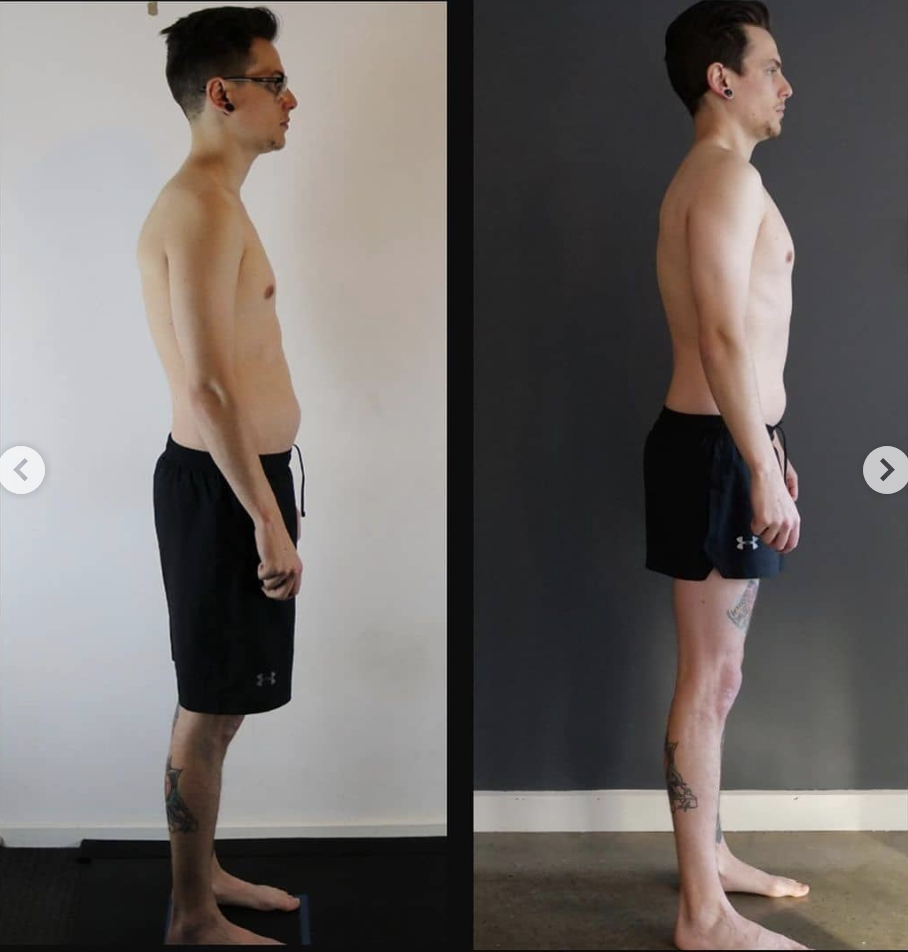A Better Way to Fix Rounded Shoulders
Why Rounded Shoulders Are So Common Today
Rounded shoulders have become one of the most common posture issues in modern life. Hours spent sitting at desks, driving, scrolling on phones or training in ways that reinforce poor movement patterns all contribute to the classic forward-rolled shoulder posture. While many people look for quick fixes — a few stretches here, a couple of isolated strengthening exercises there — these often do little more than temporarily relieve tension. To create meaningful, lasting change, we need to look at how the entire body is functioning, not just what the shoulders are doing in isolation.
How Kyphosis Feeds Into Rounded Shoulders
In many cases, rounded shoulders come paired with a thoracic kyphosis — a rounding of the upper back that pulls the ribcage down and shifts the shoulders forward. When the thoracic spine collapses, breathing becomes restricted, the upper body tightens, and the shoulders are left sitting in a position that feels difficult to correct. Trying to fix rounded shoulders without addressing this deeper structural pattern is one of the main reasons traditional approaches fail. You can stretch the chest and strengthen the upper back as much as you like, but if the ribcage and thoracic spine aren’t functioning properly, the shoulders will continue drifting forward.
Why Traditional Methods Don’t Stick
Most people have tried some version of a typical posture routine — band pull-aparts, rows, doorway stretches, holding the shoulders “back and down.” These can feel good at the time, but they often don’t make any real difference to how you move throughout the day. Posture isn’t something you can force; it’s a by-product of how efficiently your whole system is working. If your breathing mechanics, core organisation, ribcage movement and gait are compensating, the body will always revert to the patterns it knows best, even if those patterns contribute to rounded shoulders.
The Functional Patterns Difference: Training the Body as a System
At Functional Patterns Melbourne, we approach rounded shoulders from a whole-body perspective that aligns with Functional Patterns’ global methodology. Instead of isolating muscles, we train the interconnected system that determines how your body organises itself during everyday movement. This includes the Four Functional Patterns Pillars — standing, walking, running and throwing — which reflect the movements humans evolved to perform. When these patterns improve, posture follows naturally. You don’t have to think about sitting up straight or pulling your shoulders back; your body simply moves and rests in a more efficient position.
Breathing and Ribcage Mechanics: The Foundation for Better Posture
A major part of correcting rounded shoulders is restoring proper ribcage and breathing mechanics. When the diaphragm is restricted and the ribs are locked down, the upper body becomes stiff and the shoulders have nowhere to go but forward. By improving how the ribcage expands, rotates and interacts with the core, we create the conditions for natural shoulder alignment. Better breathing isn’t just about taking deeper breaths — it’s about reshaping the structure that drives your breath so your body can support efficient posture all day long.
Releasing Tension So New Patterns Can Take Hold
Over time, poor movement habits create layers of tension and restriction that make rounded shoulders feel “stuck.” That’s why part of the Functional Patterns process involves targeted myofascial release. This isn’t random stretching or foam rolling, but precise release work aimed at freeing the tissues that are holding your posture in a collapsed position. Once those restrictions ease, the body becomes far more receptive to learning new movement strategies, which is essential for long-term change.
How We Train Without Relying on Typical ‘Exercises’
Instead of giving clients a list of isolated exercises, we focus on helping them build integrated patterns that connect the shoulders, ribcage, pelvis and core into one coordinated system. Movements are designed to replicate the mechanics of real-world human function, rather than artificially isolating muscles. As you progress, we gradually increase complexity and load in a way that reinforces proper sequencing and stability. This approach helps the shoulders reposition themselves through improved mechanics, rather than through conscious effort or forced posture cues.
Gait Re-Education: The Key to Lasting Structural Change
Walking and running shape your posture more than almost anything else. If your gait reinforces a forward-rounded position, the shoulders will keep drifting into that shape no matter how much corrective work you do. That’s why gait analysis and re-patterning are central to the Functional Patterns system. When your walking and running mechanics reflect better alignment and coordination, your posture improves continuously throughout the day, not just during training sessions.
Building a Body That Moves — and Feels — Better
As the thoracic spine decompresses, the ribcage expands, and the shoulders integrate more effectively with the rest of the system, people often notice improvements in how they breathe, move and recover. Tasks that once felt stiff or uncomfortable begin to feel easier. You’re not fighting your posture anymore — your posture is working for you. By focusing on how your body functions rather than how it looks, we help you create changes that are genuinely sustainable.
The Functional Patterns Melbourne Standard
Functional Patterns Melbourne brings the global Functional Patterns methodology into a local, personalised setting. Whether you’re dealing with rounded shoulders, kyphosis or general postural discomfort, our aim is to help you rebuild your movement foundations so your posture improves naturally and your body performs at its best. When you train the movements humans are designed for, the shape of your posture becomes a reflection of a more functional, efficient system — not something you have to constantly monitor or correct.



